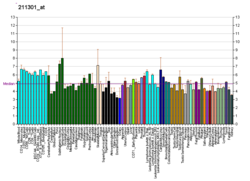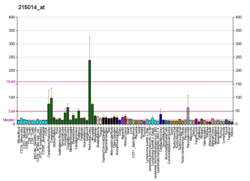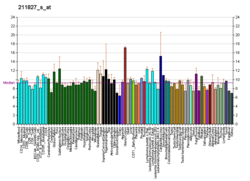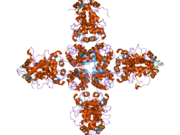KCND3
KCND3| KCND3 | |||||||||||||||||||||||||
|---|---|---|---|---|---|---|---|---|---|---|---|---|---|---|---|---|---|---|---|---|---|---|---|---|---|
 | |||||||||||||||||||||||||
| |||||||||||||||||||||||||
| 식별자 | |||||||||||||||||||||||||
| 별칭 | KCND3, KCND3L, KCND3S, KSHIVB, KV4.3, SCA19, SCA22, BRGDA9, 칼륨가이드 채널 하위 제품군 D 멤버 3 | ||||||||||||||||||||||||
| 외부 ID | OMIM: 605411 MGI: 1928743 HomoloGene: 21036 GeneCard: KCND3 | ||||||||||||||||||||||||
| |||||||||||||||||||||||||
| |||||||||||||||||||||||||
| |||||||||||||||||||||||||
| |||||||||||||||||||||||||
| 직교체 | |||||||||||||||||||||||||
| 종 | 인간 | 마우스 | |||||||||||||||||||||||
| 엔트레스 | |||||||||||||||||||||||||
| 앙상블 | |||||||||||||||||||||||||
| 유니프로트 | |||||||||||||||||||||||||
| RefSeq(mRNA) | |||||||||||||||||||||||||
| RefSeq(단백질) | |||||||||||||||||||||||||
| 위치(UCSC) | Chr 1: 111.77 – 111.99Mb | Chr 3: 105.36 – 105.58Mb | |||||||||||||||||||||||
| PubMed 검색 | [3] | [4] | |||||||||||||||||||||||
| 위키다타 | |||||||||||||||||||||||||
| |||||||||||||||||||||||||
칼륨 전압 게이트 채널 서브 패밀리 D 멤버 3(K4v.3이라고도 함)은 인간에서 KCND3 유전자에 의해 인코딩되는 단백질이다.[5][6][7]그것은 심장 활동 전위의 재분극화 단계 1에 기여하는 주요 전류인 심장의 과도현상 외부 칼륨 전류(Ito1)에 기여한다.[8]
함수
전압 게이트 칼륨(Kv) 채널은 기능적 측면과 구조적 측면에서 볼 때 가장 복잡한 등급의 전압 게이트 이온 채널을 나타낸다.이들의 다양한 기능으로는 신경전달물질 배출 조절, 심박수, 인슐린 분비, 신경 흥분성, 상피 전해질 운반, 원활한 근육수축, 세포량 조절 등이 있다.드로소필라에서 셰이커, 쇼, 샤브, 샬 등 4개의 시퀀스 관련 칼륨 채널 유전자가 확인되었으며 각각 인간 호몰로로그를 가지고 있는 것으로 나타났다.
K4v.3은 칼륨 채널의 구성원으로, 전압 게이트, 샬 관련 서브 패밀리의 구성원으로, 전압 활성 A형 칼륨 이온 채널을 형성하며, 작용 전위의 재분극 단계에서 두드러진다.이 부재는 크기가 다른 두 개의 이소폼을 포함하며, 이 유전자의 분할된 대본 변형으로 인코딩된다.[7]
임상적 유의성
기능상실은 K4v.3의 기능상실을 유발하는 베타 서브유닛 KCNE3의 돌연변이에 의해 간접적으로만 나타나지만 브루가다 증후군을 일으키는 것으로 생각된다.
참고 항목
참조
- ^ a b c GRCh38: 앙상블 릴리스 89: ENSG00000171385 - 앙상블, 2017년 5월
- ^ a b c GRCm38: 앙상블 릴리스 89: ENSMUSG000040896 - 앙상블, 2017년 5월
- ^ "Human PubMed Reference:". National Center for Biotechnology Information, U.S. National Library of Medicine.
- ^ "Mouse PubMed Reference:". National Center for Biotechnology Information, U.S. National Library of Medicine.
- ^ Postma AV, Bezzina CR, de Vries JF, Wilde AA, Moorman AF, Mannens MM (Aug 2000). "Genomic organisation and chromosomal localisation of two members of the KCND ion channel family, KCND2 and KCND3". Hum Genet. 106 (6): 614–9. doi:10.1007/s004390050033. PMID 10942109.
- ^ Gutman GA, Chandy KG, Grissmer S, Lazdunski M, McKinnon D, Pardo LA, Robertson GA, Rudy B, Sanguinetti MC, Stuhmer W, Wang X (Dec 2005). "International Union of Pharmacology. LIII. Nomenclature and molecular relationships of voltage-gated potassium channels". Pharmacol Rev. 57 (4): 473–508. doi:10.1124/pr.57.4.10. PMID 16382104. S2CID 219195192.
- ^ a b "Entrez Gene: KCND3 potassium voltage-gated channel, Shal-related subfamily, member 3".
- ^ Oudit GY, Kassiri Z, Sah R, Ramirez RJ, Zobel C, Backx PH (May 2001). "The molecular physiology of the cardiac transient outward potassium current (I(to)) in normal and diseased myocardium". J. Mol. Cell. Cardiol. 33 (5): 851–72. doi:10.1006/jmcc.2001.1376. PMID 11343410.
추가 읽기
- Serôdio P, Vega-Saenz de Miera E, Rudy B (1997). "Cloning of a novel component of A-type K+ channels operating at subthreshold potentials with unique expression in heart and brain". J. Neurophysiol. 75 (5): 2174–9. doi:10.1152/jn.1996.75.5.2174. PMID 8734615.
- Kong W, Po S, Yamagishi T, et al. (1999). "Isolation and characterization of the human gene encoding Ito: further diversity by alternative mRNA splicing". Am. J. Physiol. 275 (6 Pt 2): H1963–70. doi:10.1152/ajpheart.1998.275.6.H1963. PMID 9843794.
- Dilks D, Ling HP, Cockett M, et al. (1999). "Cloning and expression of the human kv4.3 potassium channel". J. Neurophysiol. 81 (4): 1974–7. doi:10.1152/jn.1999.81.4.1974. PMID 10200233.
- Isbrandt D, Leicher T, Waldschütz R, et al. (2000). "Gene structures and expression profiles of three human KCND (Kv4) potassium channels mediating A-type currents I(TO) and I(SA)". Genomics. 64 (2): 144–54. doi:10.1006/geno.2000.6117. PMID 10729221.
- Deschênes I, Tomaselli GF (2002). "Modulation of Kv4.3 current by accessory subunits". FEBS Lett. 528 (1–3): 183–8. doi:10.1016/S0014-5793(02)03296-9. PMID 12297301.
- Strausberg RL, Feingold EA, Grouse LH, et al. (2003). "Generation and initial analysis of more than 15,000 full-length human and mouse cDNA sequences". Proc. Natl. Acad. Sci. U.S.A. 99 (26): 16899–903. Bibcode:2002PNAS...9916899M. doi:10.1073/pnas.242603899. PMC 139241. PMID 12477932.
- Ren X, Shand SH, Takimoto K (2003). "Effective association of Kv channel-interacting proteins with Kv4 channel is mediated with their unique core peptide". J. Biol. Chem. 278 (44): 43564–70. doi:10.1074/jbc.M302337200. PMID 12928444.
- Hatano N, Ohya S, Muraki K, et al. (2004). "Two arginines in the cytoplasmic C-terminal domain are essential for voltage-dependent regulation of A-type K+ current in the Kv4 channel subfamily". J. Biol. Chem. 279 (7): 5450–9. doi:10.1074/jbc.M302034200. PMID 14645239.
- Scannevin RH, Wang K, Jow F, et al. (2004). "Two N-terminal domains of Kv4 K(+) channels regulate binding to and modulation by KChIP1". Neuron. 41 (4): 587–98. doi:10.1016/S0896-6273(04)00049-2. PMID 14980207. S2CID 17380435.
- Zicha S, Xiao L, Stafford S, et al. (2005). "Transmural expression of transient outward potassium current subunits in normal and failing canine and human hearts". J. Physiol. 561 (Pt 3): 735–48. doi:10.1113/jphysiol.2004.075861. PMC 1665387. PMID 15498806.
- Frank-Hansen R, Larsen LA, Andersen P, et al. (2005). "Mutations in the genes KCND2 and KCND3 encoding the ion channels Kv4.2 and Kv4.3, conducting the cardiac fast transient outward current (ITO,f), are not a frequent cause of long QT syndrome". Clin. Chim. Acta. 351 (1–2): 95–100. doi:10.1016/j.cccn.2004.08.017. PMID 15563876.
- Baltaev R, Strutz-Seebohm N, Korniychuk G, et al. (2005). "Regulation of cardiac shal-related potassium channel Kv 4.3 by serum- and glucocorticoid-inducible kinase isoforms in Xenopus oocytes". Pflügers Arch. 450 (1): 26–33. doi:10.1007/s00424-004-1369-z. PMID 15578212. S2CID 190895.
- Radicke S, Cotella D, Graf EM, et al. (2005). "Expression and function of dipeptidyl-aminopeptidase-like protein 6 as a putative β-subunit of human cardiac transient outward current encoded by Kv4.3". J. Physiol. 565 (Pt 3): 751–6. doi:10.1113/jphysiol.2005.087312. PMC 1464568. PMID 15890703.
- Gregory SG, Barlow KF, McLay KE, et al. (2006). "The DNA sequence and biological annotation of human chromosome 1". Nature. 441 (7091): 315–21. Bibcode:2006Natur.441..315G. doi:10.1038/nature04727. PMID 16710414.
- Lundby A, Olesen SP (2006). "KCNE3 is an inhibitory subunit of the Kv4.3 potassium channel". Biochem. Biophys. Res. Commun. 346 (3): 958–67. doi:10.1016/j.bbrc.2006.06.004. PMID 16782062.
- Ahmed I, Cosen-Binker LI, Leung YM, et al. (2007). "Modulation of the K(v)4.3 channel by syntaxin 1A". Biochem. Biophys. Res. Commun. 358 (3): 789–95. doi:10.1016/j.bbrc.2007.04.182. PMID 17506992.
- Potapova IA, Cohen IS, Doronin SV (2007). "Voltage-gated ion channel Kv4.3 is associated with Rap guanine nucleotide exchange factors and regulates angiotensin receptor type 1 signaling to small G-protein Rap". FEBS J. 274 (17): 4375–84. doi:10.1111/j.1742-4658.2007.05966.x. PMID 17725712.
외부 링크
- Brugada 증후군에 대한 GeneReviews/NIH/NCBI/UW 입력
- Kv4.3+칼륨+채널(미국 국립 의학 라이브러리 의료 과목 제목)
- PDBe-KB에서 UniProt: Q9UK17(Cantium voltage-gated channel subfamily D 멤버 3)에 대해 PDB에서 사용할 수 있는 모든 구조 정보 개요.
이 기사는 공공영역에 있는 미국 국립 의학 도서관의 텍스트를 통합하고 있다.












